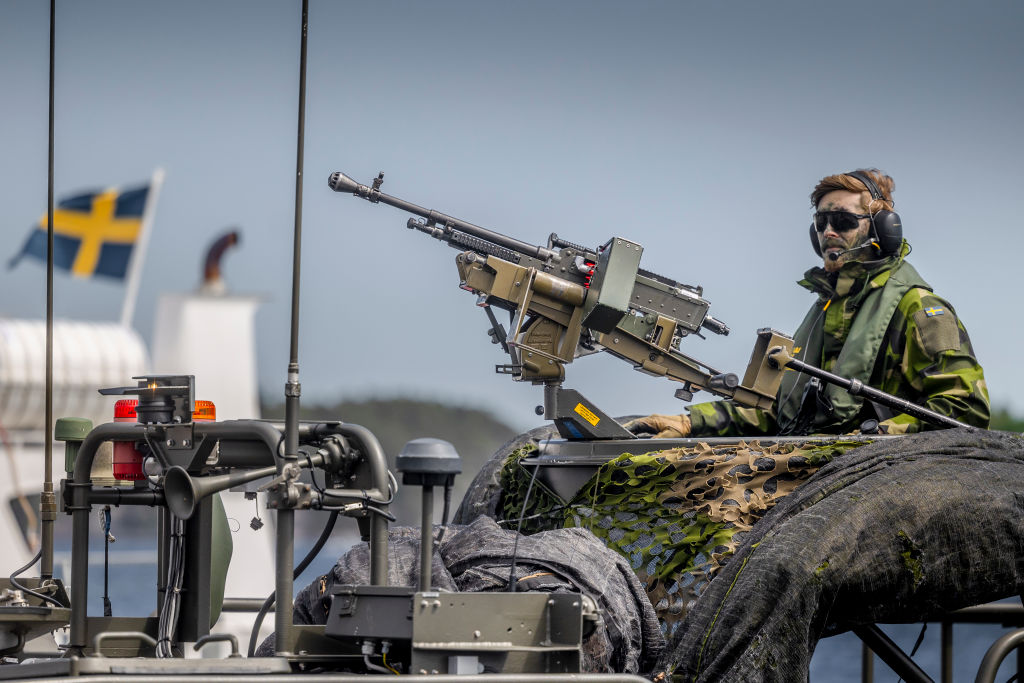Sweden joining NATO creates crisis for Russian Baltic Fleet

VÄRMDÖ, SWEDEN – A Swedish soldier sits on a military boat with a machine gun during the Baltic Operations NATO military drills (Baltops 22). (Photo by Jonas Gratzer/Getty Images)
SUMMARY
Russia's Baltic Fleet already had a tough transit when it needed to go anywhere. It's based largely near St. Petersburg and in the Kaliningrad Enclave. For decades, when it left St. Petersburg, it needed to pass in the narrow waters between Finland and NATO member Estonia. When it left the Baltic Sea, it had to pass within spitting distance of NATO member Denmark. With the addition of Finland and, soon, Sweden, the Baltic Sea will be a NATO lake.
Russia's Baltic Fleet
Russia's Baltic Fleet is its smallest, but it has an outsized strategic importance. Russia, as well as its potential rivals and adversaries in Europe, rely on the Baltic Sea to import and export a large number of goods. The Baltic marine area typically has thousands of ships transit every month, with 3,500-5,500 measured per month in a 2018 report.
The sabotaged Nord Stream pipelines both run through the Baltic Sea, as well. And the Russian navy base on the Kaliningrad Enclave is its only Atlantic-facing base that is ice-free year-round. In recent years, Russia has invested heavily in its defenses.
The Baltic Fleet has 52 vessels, including modern submarines. And Russia slated its six of the upcoming Lada-class advanced submarines for the Baltic. Despite the ongoing hostilities in Ukraine, Russia has prioritized the Baltic Sea and kept most of the ships, missiles and planes assigned to the region at home. (Ground forces from the area have, reportedly, been deployed to Ukraine and suffered heavy losses.) And, it has continued to hold large exercises there.
As retired Coast Guard Capt. Lawson Brigham said in a Proceedings article:
Russia has strategic interests in the Baltic Sea region—notably, exporting oil by tankers and gas by pipeline, and projecting power with its Baltic Sea Fleet. Unrestricted access for commercial and naval vessels to the open ocean through the Danish Straits is paramount for Russia, and regional air, sea, and land control are among its most visible, proactive pursuits.
All of which is to say, Russia has vital interests in the Baltic Sea and everyone knows it.
This sucks for Russia, since the accession of Finland and now Sweden means it will be the only non-NATO member that borders the sea.
Sweden is joining NATO
Sweden announced its plans to join NATO at the same time as Finland. But while NATO quickly welcomed Finland, a surprise protest by Turkey froze Sweden's accession plans. Finland officially joined the alliance April 4, and Sweden has been in limbo since.
But in a surprise announcement Monday night, on the literal eve of a NATO summit, Turkey's President Recep Tayyip Erdoğan announced that his country backed Swedish accession. With Erdoğan's backing, Sweden could join in weeks. The only other holdout, Hungary, has already said it doesn't want to be the last to ratify Sweden's membership.
When the treaties are ratified, Sweden will be the 32nd member of NATO and it will deliver 2,000 miles of Baltic coastline to the alliance, as well as top-tier military equipment like the Gotland-class submarine.
Not only does this mean that the Baltic Sea is a NATO lake except for a few Russian aberrations, it means there are new chokepoints where NATO can track Russian submarines and other ship traffic.
Now, all ships or submarines leaving St. Petersburg will have to pass between NATO members Finland and Estonia. In fact, ships will have to pass within 20 miles of two NATO capitals, as both Tallinn and Helsinki are on the Gulf of Finland.
As ships leave the gulf, it just gets worse for the Russians. The Danish straits are already quite tight, and three of the major passageways through them were entirely NATO-controlled. With the accession of Sweden, the sole remaining passageway, "Oresund" or "the Sound," is entirely NATO-controlled, as well.
In fact, it's now impossible to take a boat on the water from St. Petersburg to the Atlantic without passing under a NATO bridge, as Denmark and Sweden have road connections across the thin straits.
Russia's Baltic Fleet is now, more than ever, going to be its Alamo if it starts a war with NATO.
SHARE
